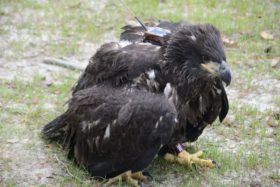Incubation (Brood) Patch
Azalea Returns to Little Neck, Va Beach
March 5, 2011Camellia Back in Great Neck 3/8
March 8, 2011
Today March 5 at Norfolk Botanical Garden photographer Shelly Fowler captured an outstanding image of the incubation patch – also known as the brood patch – on the female bald eagle. So just what is the brood patch and do all birds develop one during the breeding season? No – not all birds develop a brood patch. Some birds like the blue-footed booby use their feet in place of a brood patch. Some birds like gulls and plovers have three brood patches, and other birds like pelicans and cormorants do not have an incubation patch at all. Usually only the sex that incubates the eggs gets a brood patch such as male phalaropes do but the females do not because only the male incubates their eggs. In such species as the bald eagle, they both develop an incubation patch because, as we see each day, they both share the incubation duties.
The incubation patch begins to develop on the breast or abdomen shortly before the female lays her eggs through hormonal changes that cause the feathers that cover that area to fall out on their own. That leaves a wrinkled patch of bare skin that blood vessels fill with warm blood. When we see the female or male “wiggle” as they settle upon the eggs, they are spreading that bare patch over the eggs to keep them warm.
We should begin to see eaglets in about a week. I have spent time this week reviewing production records from the annual bald eagle surveys taken in Virginia by The Center for Conservation Biology. Only one other pair of Virginia bald eagles – in Prince George County (nest PG0602) – has consistantly produced three eggs like this pair at Norfolk Botanical Garden!! We have really been priveleged viewers.
Copywrited photograph used with permission of Shelly Fowler.




11 Comments
Wonderful photo! It has been so interesting to follow these eagles and their nest. We have a nest in our area, but it is so far away, getting photos is difficult.
Thank you so much for the teaching comments Reese. Thank you Shelly for the fabulous picture. After Three years of watching this is the first I have seen or heard of the brood patch. Wonderful!!
Reese, thanks for the great info on the brood patch. I didn’t realize the process of the incubation patch!
TV watching has gone by the wayside. I spend a lot of time watching this and am learning new things about eagles every day. Love it!
Thanks for the info Reese. With Shelly’s picture and your explanation, is it very clear now. One question though. Does the male eagle go through hormonal changes too or is the process of his brood patch different than the female.
Response – Hormonal change for both.
The Beauty Of God Creation. What a Gift to of been able to have seen this much so far ,Thank you so much. I’m forever Greatful.
OK Reese…. today is the 10th.. what day do you expect to see the first hatch?
Response – Based on their past performance – the 12th or 13th.
absolutely magnificent phot and creature
I have a nesting pair of bald eagles 200 ft from my mailbox!! This is a first in Mt. Pleasant, Tx…and the community and game warden are so thrilled. Last year’s chicks died of a freak hailstorm…but 2 eaglets are wobbling around this year!
Response – Lucky you. Wishing better success in 2011.
Great shot sis and interesting article
Love the teaching you do as well as just enjoying the Eagles. The next 80 days will see dust bunnies at my home, whie I watch the antics of the young.